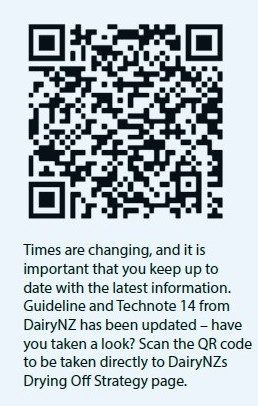Lisa Whitfield
Back in 2016 the New Zealand Veterinary Association released its’ position statement which included the following direction:
“By 2020, DCT (Dry Cow Therapy) will only be used in the treatment of existing intramammary infections.”
If you have looked at the calendar recently you will realise that 2020 is here. So how does this affect you?
Traditionally antibiotic dry cow therapy has had two functions.
- To prevent a cow acquiring a new intramammary infection over the dry period
- To treat intramammary infections which are present at the time of drying off.
From now on, the preventative function of antibiotic dry cow therapy is no longer a valid reason to use it, and dry cow antibiotics should only be used for the treatment of infections which are already present at drying off.
We have access to good internal teat sealant products which outperform antibiotic dry cow therapy in the field of preventing new intramammary infections over the dry period, and all cows are candidates to receive an internal teat sealant at drying off.
For you, the dairy farmer, this means that to justify to your vet that a cow needs to receive dry cow therapy, you should have evidence provided to prove that she needs it.
Taking this to the extreme, as has been done in other countries, this may one day mean that a bacterial culture performed on the milk from each cow has to be done to show which individual cows have an infection requiring treatment. This approach would currently be considered the gold standard for appropriate use of dry cow antibiotics.
At this stage the approach in NZ has been a few steps below this.
In NZ, it is acceptable for a cow to have a high cell count in order to prove that she has infection which needs treating.
This means that either a recent herd test result or a rapid mastitis test (RMT) result is acceptable evidence of infection.
As the season rapidly draws to a close, have you thought about the implications of this for your herd? Do you have this evidence available to you?
There is no excuse for anyone not to have this information. A herd test performed within the last 80 days prior to drying off means that for a May 30 dry off date, any herd test performed after March 10 is going to be useful to make drying off decisions. If you haven’t organised a late herd test, you can go through your herd with an RMT paddle and still get good information for making drying off decisions.
Whole herd antibiotic dry cow therapy is only rarely justifiable. There are many examples of herds which use very low rates of antibiotic dry cow therapy (>10% of cows) and also have low seasonal bulk tank SCC and low clinical mastitis cases. Antibiotics are only one tool in the kit for fixing mastitis problems and should not be relied on as a sole means of managing mastitis problems.
- Lisa Whitfield – Production Animal Veterinarian




